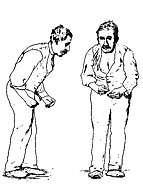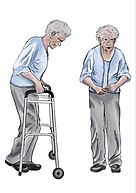Parkinson's disease (PD), or simply Parkinson's, is a long-term neurodegenerative disease of mainly the central nervous system that affects both the motor and non-motor systems of the body. The symptoms usually emerge slowly, and as the disease progresses, non-motor symptoms become more common. Usual symptoms include tremors, slowness of movement, rigidity, and difficulty with balance, collectively known as parkinsonism. Parkinson's disease dementia, falls and neuropsychiatric problems such as sleep abnormalities, psychosis, mood swings, or behavioral changes may arise in advanced stages as well.
Most cases of Parkinson's disease are sporadic, but a few contributing factors have been identified. Pathophysiology is characterized by nerve cell death in the locus coeruleus and substantia nigra, the latter being a midbrain region that supplies dopamine to the basal ganglia that are involved in voluntary motor control. The cause of this cell death is poorly understood but includes the alpha-synuclein aggregation into Lewy bodies within the neurons. Other possible factors involve genetic and environmental mechanisms as well as medications, lifestyle, or previous conditions.
Diagnosis is mainly based on signs and symptoms, usually motor-related, found via neurological examination, though medical imaging like neuromelanin MRI can support the diagnosis. Usual onset is in people over 60 years of age of whom about one percent are affected. In those younger than 50, it is termed "early-onset PD".
No cure is known, and treatment aims to mitigate symptoms. Initial treatment typically includes L-DOPA, MAO-B inhibitors, or dopamine agonists. As the disease progresses, these medications become less effective and produce a side effect marked by involuntary muscle movements. Diet and certain forms of rehabilitation have shown some effectiveness at improving symptoms. Deep brain stimulation has been used to reduce severe motor symptoms where drugs are ineffective. There is little evidence for treatment of the non-movement-related symptoms, such as sleep disturbances and mood instability. The average life expectancy is near-normal.
- ^ a b c "Parkinson's Disease Information Page". NINDS. 30 June 2016. Retrieved 18 July 2016.
- ^ Truong & Bhidayasiri 2016, p. 188.
- ^ Ferri 2010, Chapter P.
- ^ Koh J, Ito H (January 2017). "Differential diagnosis of Parkinson's disease and other neurodegenerative disorders". Nihon Rinsho. Japanese Journal of Clinical Medicine. 75 (1): 56–62. PMID 30566295.
- ^ Sveinbjornsdottir S (October 2016). "The clinical symptoms of Parkinson's disease". Journal of Neurochemistry. 139 (Suppl 1): 318–324. doi:10.1111/jnc.13691. PMID 27401947.
- ^ Ou Z, Pan J, Tang S, Duan D, Yu D, Nong H, et al. (7 December 2021). "Global Trends in the Incidence, Prevalence, and Years Lived With Disability of Parkinson's Disease in 204 Countries/Territories From 1990 to 2019". Frontiers in Public Health. 9: 776847. doi:10.3389/fpubh.2021.776847. PMC 8688697. PMID 34950630.



